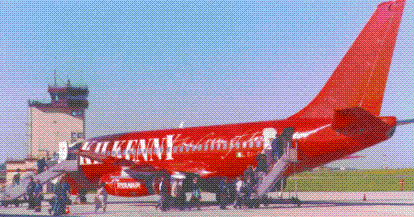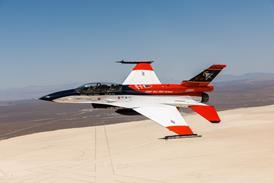Ed Reavis/FRANKFURT

Two German airports regain economic ground lost when the US Air Force left
With the end of the East-West confrontation and the following military drawdown, Germany's economy suffered major after-shocks from the closure of several major US military installations. Among those given up by the US Air Force were Hahn and Zweibrucken, respectively a former Lockheed Martin F-16 fighter base and one that previously housed McDonnell Douglas RF-4 Phantoms reconnaissance aircraft and Shorts C-23 Sherpa transport planes.
Both of the former military bases were in the economic backwaters of the Rheinland-Pfalz region and, after the German military showed no interest in either, the communities had only one choice: for economic survival, new users had to be found. Zweibrucken was returned to the German Government in September 1991, and Hahn two years later. Today, each has found new identities catering to different segments of the aviation industry.
Hahn Airport
Until the early 1990s, Hahn AB was home to 9,000 airmen, their families and more than 800 civilians. "Our goal from the very beginning was to convert Hahn into an internationally recognised airport," says Maria Horbert of Hahn Airport. She says the right combination of shareholders, which included the government of Rheinland-Pfalz (which held the bulk), the same-named Rheinland-Pfalz county and a private holding firm, has given Hahn Airport the right mixture of political and airport technical support.
Rheinland-Pfalz purchased from the federal government the total US base area of 571Ha (1,412 acres) for DM37 million ($19.3 million) in September 1994. The airport real estate itself extends over 320Ha. Joint use of the airfield with the USAF continued from December 1992 to September 1993 when it was turned over entirely to the Germans with the caveat that NATO would have use of all service facilities in case of any defence necessity. Resolving soil contamination problems and redevelopment measures cost more than DM5 million before the airport was able to handle its first charter flights to Mallorca in May 1993, when civilians and the USAF still shared the field.
Business success for Hahn came early last year when the Turkish carrier MNG Airlines became the first freight line to start regular flying operations. Iranian Payam Aviation soon followed and the trend continues as more airlines opt for Hahn. The airport is used by 57 cargo companies and 25 charter passenger airlines. Freight handling is an important element of the original conversion plan and numerous building projects are being undertaken to improve the infrastructure for freight handling. In July 1997, Hahn landed its biggest business coup by convincing Air France to concentrate all nine of its German freight centre activities at the airport.
Pure air freight has increased by almost 200%, weighing in last year at 15,000t. Taking into account the air freight replacement traffic transported by road, it turned over a freight total of 130,000t, making Hahn the 10th largest airport in Germany in freight terms. On the passenger side, 29,000 passengers used Hahn Airport, mainly for holiday flights to Palma de Mallorca, Tenerife and La Gomera. This year, Ryanair began offering three flights a day from Hahn to London Stansted.
In January last year, Frankfurt International Airport took over the majority holdings of Hahn from the state. Frankfurt Airport authorities say: "Hahn has become an important asset, particularly for handling charter and cargo overflow and it's destined to become even more important in the future. It has extremely competitive prices and has a 24h operation licence for Chapter III aircraft."
Frankfurt Airport's involvement means professional and secure handling, assistance in airport related and airport operational issues for Hahn. Expert predictions that German passenger traffic will pass 200 million by 2004 is further good news for Hahn's. Most existing commercial airports in the country already operate at capacity, while Hahn passenger figures have nearly tripled from 7,000 in 1993 to 20,000 in 1998.
Demographics show Hahn Airport has 1.5 million inhabitants within a 45min radius, 2.8 million inhabitants within 90min and 3.4 million inhabitants with 120min. "This is the optimal time for Flughafen Hahn to be operating. Major investments in technology and state of the art ground installation makes take-off and landings here possible in almost any weather due to our category IIIa instrument landing system [ILS]," Horbert says.
Located 1,649ft (503m) above sea level in a rural setting between the Rhein, Nahe and Mosel rivers, Hahn Airport has a 3,040m runway which is 150m wide and has a 300m overrun area at each end.
The airport's existing four-apron capacity of 99,900m2 (1 million ft2) was due to increase to 127,000m2 on 18 July, enabling two jumbo jets to be handled simultaneously. A new taxiway to the runway and two turning areas at the ends of the runway will also increase the airport's attraction to potential business.
Other features of the airport conversion include hotels and inns, restaurants, the 600-student Rheinland-Pfalz police academy and even a nine-hole golf course. "In the five years since flying operations began," Horbert says, "Hahn Airport has developed into a new centre for business, with room for over 60 companies providing work for more than 800 employees at the airport and 3,000 new jobs in the region. We're over the hill with our conversion adventure."
Hahn Airport is about 100km (62 miles) from Frankfurt and can be reached by a shuttle bus from Frankfurt's main railway station or by train and bus via Mainz or automobile. A new terminal is under construction.
Zweibrücken Airport
Conversion of the USAF base in Zweibrücken started a year earlier than at Hahn but it cannot claim to be "over the hill" yet, although airport director and Zweibrücken Lord Mayor Jürgen Lambert is optimistic about the former base's future.
"Of course it was a shock when we heard the Americans were leaving. This is an economically deprived region with few job opportunities. The Americans not only left the air base but also two caserns [USArmy installations] we had to convert," Lambert says. The town's first act after the US military left was to run a week-long information seminar for potential investors and businesses on feasible conversion ideas. It was decided to add a large commercial centre on the former base and the idea caught on. Lambert called the airport and the 60 commercial undertakings opened there, easing the region's depressed job market.
Zweibrücken AB had employed 1,000 airmen and 300 civilians. Businesses based there, including a civilian airport, now employ 600 people. When the USAF left it turned the base over to the German federal government for DM40 million with Zweibrücken GmbH in turn purchasing it from the German federal government for DM40 million. "Experts at the time gave us a ballpark estimate that the cost of a pollution clean-up would run to DM250 million," Lambert said. "Now, after exact analysis of the problem they say it will cost but a fraction of their first estimate."
Zweibrücken GmbH next formed three separate organisations to oversee various aspects of converting the base into a civilian airport and administering the entire 310Ha of the base. A 52Ha area on the base was sold for DM13 million to an investor who plans to open a large factory outlet centre. "Diversification and private investors was our idea from the beginning," said Edgar Steiger, director of Aircity, the organisation that administers the base's real estate.
On 28 May, 1994 the first civilian aircraft landed in Zweibrücken. Flight service officially began on 2 September of the same year. At the time, the airport was only licensed for non-precision approaches.
In April it fulfilled the technical requirements as a ILS Category I airport. Zweibrücken registered 11,332 take-offs and landings last year with the emphasis on passenger traffic. "We can handle freight," Lambert says, "but Hahn Airport is specialising in that segment. We want to concentrate on attracting business and charter flight trade."
The 2,135m-long runway can accommodate larger aircraft such as the Boeing 737 or Airbus A320.
Predictions that German tourism will continue to be a growth industry has Lambert optimistic about the future even without a strong partner as Hahn has in Frankfurt International Airport. Zweibrücken has contracted for a new passenger terminal in the year 2000 to handle 350 to 500,000 passengers.
Source: Flight International
















